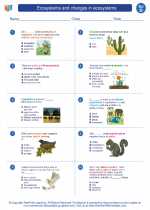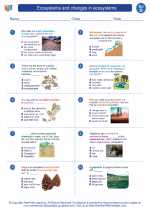Ecosystems and changes in ecosystems -> eukaryotic
Eukaryotic Cells
Eukaryotic cells are one of the two major types of cells, the other being prokaryotic cells. Eukaryotic cells are found in plants, animals, fungi, and protists. They are defined by the presence of a nucleus and other membrane-bound organelles. These cells are more complex and larger in size compared to prokaryotic cells.
Characteristics of Eukaryotic Cells
- Nucleus: Eukaryotic cells have a distinct nucleus that houses the genetic material (DNA) enclosed within a nuclear membrane.
- Membrane-bound organelles: Eukaryotic cells contain various membrane-bound organelles such as mitochondria, endoplasmic reticulum, Golgi apparatus, and lysosomes, each performing specific functions within the cell.
- Cytoskeleton: Eukaryotic cells have a cytoskeleton made up of microtubules, microfilaments, and intermediate filaments, providing structural support and facilitating intracellular transport.
- Complex cellular organization: Eukaryotic cells have a complex internal organization with specialized compartments and structures for various cellular processes.
- Reproduction: Eukaryotic cells reproduce through either mitosis (for somatic cells) or meiosis (for reproductive cells), leading to the formation of new eukaryotic cells.
Study Guide
When studying eukaryotic cells, it is essential to focus on the following key points:
- Understanding the structure and function of the nucleus and other membrane-bound organelles.
- Comparing and contrasting eukaryotic cells with prokaryotic cells to grasp their differences in organization and complexity.
- Exploring the roles of the cytoskeleton in maintaining cell shape, enabling cell movement, and facilitating intracellular transport.
- Learning about the processes of mitosis and meiosis, and how they contribute to the reproduction and growth of eukaryotic organisms.
- Examining the diversity of eukaryotic cells within different organisms, including plants, animals, fungi, and protists.
By grasping these fundamental concepts, you will develop a comprehensive understanding of eukaryotic cells and their significance in the functioning of living organisms.
[Eukaryotic] Related Worksheets and Study Guides:
.◂Science Worksheets and Study Guides Fourth Grade. Ecosystems and changes in ecosystems
Study Guide Ecosystems and changes in ecosystems
Ecosystems and changes in ecosystems  Worksheet/Answer key
Worksheet/Answer key Ecosystems and changes in ecosystems
Ecosystems and changes in ecosystems  Worksheet/Answer key
Worksheet/Answer key Ecosystems and changes in ecosystems
Ecosystems and changes in ecosystems  Worksheet/Answer key
Worksheet/Answer key Ecosystems and changes in ecosystems
Ecosystems and changes in ecosystems  Vocabulary/Answer key
Vocabulary/Answer key Ecosystems and changes in ecosystems
Ecosystems and changes in ecosystems  Vocabulary/Answer key
Vocabulary/Answer key Ecosystems and changes in ecosystems
Ecosystems and changes in ecosystems  Vocabulary/Answer key
Vocabulary/Answer key Ecosystems and changes in ecosystems
Ecosystems and changes in ecosystems 

 Worksheet/Answer key
Worksheet/Answer key
 Worksheet/Answer key
Worksheet/Answer key
 Worksheet/Answer key
Worksheet/Answer key
 Vocabulary/Answer key
Vocabulary/Answer key
 Vocabulary/Answer key
Vocabulary/Answer key
 Vocabulary/Answer key
Vocabulary/Answer key

The resources above cover the following skills:
Life Science
There is interaction and interdependence between and among living and nonliving components of ecosystems. Students can:
Identify the components that make a habitat type unique
Compare and contrast different habitat types